Dastan Family in Shahnameh
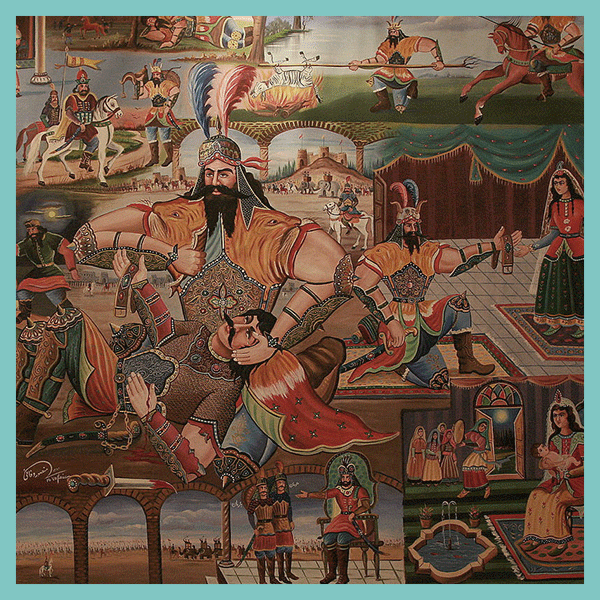
یکی از اِفتِخاراتِ زبانِ فارسی، اَدَبیات و فَرهَنگِ شاعرانهیِ بسیار غَنی آن است. اَشعار و دیوانهایِ شاعرانِ قدیمِ ایران، مانند فِردوسی، رودَکی، عَطار، خَیام، سَعدی، مولانا و حافظ به زبانهایِ مُختَلِفی تَرجُمه شدهاند و طَرفدارانِ زیادی دارند. اما گاهی فارسیآموزان میخواهند این شعرها را به زبانِ اَصلیشان، یعنی فارسی بخوانند. از همین رو، گروه فارسیموند تصمیم گرفته است بخشِ جدیدی در صَفحهی ادبیات خود به عنوانِ راهنمایِ خواندنِ شعرِ فارسی اِضافه کند.
Persian speakers are honored for their rich literature and poetry-oriented culture. Many Persian classics by Ferdowsi, Roudaki, Attar, Khayyam, Sadi, Rumi, and Hafiz are translated into different languages. But some Farsi learners prefer to enjoy reading them in their original language. Therefore, the FarsiMonde group has decided to add a new page to their website as a guideline to help Farsi learners with reading Persian poetry.
نُخُستین کتابی که برای این بَخش انتخاب کردیم، شاهنامهی فردوسی، از شِناخته شدهترین مَنظومههای حماسیِ جهان است. دربارهی نگارشِ این کتاب و شاعر آن، فردوسی، داستانها و روایتهای زیادی گفته شده است. اما ما در این بخش، قَصدِ بَررسی کردنِ این داستانها و سَنجِشِ دُرُستی آنها را نداریم. هَدَفِ اصلی این بخش، راهنمایی فارسیآموزان علاقهمند به شعرِ فارسی است تا بتوانند این شعرها را راحتتر بخوانند. شاهنامه، سِیری داستانی از دوران پیش از اسلام با شَخصیَتهایِ گوناگون دارد. آشنا شدن با این شَخصیَتها و داستانِ زندگیشان، به شما کمک خواهد کرد تا دَرکِ بهتری از داستانهایِ شاهنامه داشته باشید. امروز، با پَنج شخصیتِ مهم شاهنامه از خانوادهی دَستان و پرندهی نجاتدهندهاشان، سیمرغ، آشنا میشویم.
The first selected book for this part is Shahnameh, Ferdowsi’s masterpiece and one of the most-known epics in the world. There are many contradictory stories about Ferdowsi and Shahnameh. But in this part, we do not aim to narrate or validate these stories. Our focus is to provide a guideline for Farsi learners to help them read Farsi poems. Shahnameh contains a series of stories about different pre-Islamic eras in the Persian Empire and hundreds of characters. Knowing the characters may help you understand the stories better. Today, you will learn about five important figures of the Dastân family and their savior bird, Simurgh.
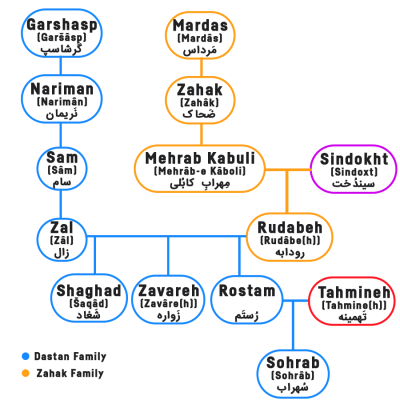
نَریمان
نَریمان، پدرِ سام، پدربزرگِ زال، و جَدِ رُستم، از نسل گَرشاسپ و از اَوَلین پَهلَوانانِ بزرگِ شاهنامه است. او در دورانِ پادِشاهی فِریدون در مَنطَقهی زابُلستان زندگی میکرده است. در داستانهایی از شاهنامه گفته شده است که در یک جَنگ، نزدیک دِژی به نام سِپَند، تَخته سَنگِ بسیار بزرگی از بالای دِژ بر سَرِ نَریمان پَرتاب شده و او را کُشته است. سالها بَعد و در زمانِ پادشاهیِ نُوذَر، وقتی که رُستَمِ نوجَوان داستانِ مَرگِ نَریمان را از زال میشنود، بیدِرَنگ به سمت دِژِ سِپَند حَمله میکند، اِنتِقامِ او را میگیرد و به سادِگی دِژِ سپند را میگُشایَد.
Nariman
Narimân is Sâm’s father, Zâl’s grandfather, and Rostam’s great-grandfather. He is one of Garšâsb’s descendants and one of the first great heroes of Shahnameh. Narimân was living at the time of Fereydun in the Zabolestân region. According to a narration from Shahnameh, a big stone was thrown on his head and killed him during a war near a fortress called Sepand. Years later, during the rule of King Nozar, Zâl narrates this story to adolescent Rustam who immediately invades the fortress, avenges Narimân’s death, and easily opens Sepand’s fortress.
سام
سام فرزندِ نَریمان، پدرِ زال، و پدربزرگ رُستم، بزرگترین پَهلَوان در زمان پادشاهی مَنوچِهر بود که به مَنوچَهر برایِ اِنتقامِ ایرج کمک کرد. حُضورِ سام در شاهنامه پُررَنگ نیست، اما دربارهی او میتَوان به این اِشاره کرد که هَرگِز در هیچ مأموریَت و جَنگی شِکَست نخورد. بزرگترین اِشتباهِ سام در شاهنامه زمانِ تَوَلدِ پسرش، زال، رُخ داد. وقتی سام دید که نوزاد، مو، مُژه و اَبروهایِ سفیدی دارد، او را بَدشُگون اِنگاشت و نوزاد را در میان کوههای اَلبُرز رَها کرد. سالها بَعد، سام از این کار خود پَشیمان شد و برای پیدا کردنِ زال به همان مَنطَقه رفت. زال به کمکِ سیمُرغ، جَوانی زیبا و قَوی شده بود. سام، او را با خود به خانهاش بَرگرداند و برای دِلجویی از او تَمام تَلاشَش را کرد، اما هیچگاه نتوانست دِلِ زال را به طور کامل به دست آوَرد. سام در زابُلستان بَر اَثَر پیری دَرگُذَشت.
Sam
Sâm, Narimân’s son, Zâl’s father, and Rostam’s grandfather was the most salient hero during the rule of King Manučehr. He helped the king to take revenge for Iraj’s death. Sâm does not have a main role in Shahnameh, but he is one of the champions who never failed in any mission or war. However, Sâm made an unforgivable mistake when his son, Zâl, was born. Zâl had white hair, eyelashes, and eyebrows. Sâm considered it a bad omen; therefore, left the infant Zâl in Alborz Mountain where Simorgh saved and raised him like her son. Years later, Sâm regret what he did and went to the region to take Sâm back home. By that time, Zâl was a handsome and strong man. Despite all Sâm’s attempts to appease Zâl for being abandoned, he could not forgive Sâm completely. Sâm finally died in Zabolestân of old age.
زال
زال، فَرزندِ سامِ دَستان، بزرگترین پهلوانِ زَمانهی خود بود. وَقتی زال به دنیا آمد، تَمامِ موهای سرش هَمچون پیرمردها سِفید بود. در آن زمان، کودکان مبتلا به آلبینیسم را از نژادِ اَهریمن میدانستند. به همین دلیل، سام، از تَرسِ سَرزَنش شدن، نوزاد را در کوههای اَلبُرز رَها کرد. سیمُرغ، نوزاد را پیدا کرد، او را به آشیانهی خود برد و در کِنارِ بچههایش بزرگ کرد. سالها بعد، سام از رَها کردنِ زال پشیمان شد و به کوهستانِ اَلبرز رفت و او را پیدا کرد. با این حال، زال هَرگز پدر خود را کاملاً نَبخشید و تا دورانِ پیری همیشه از رَها شدنش در کوهستان ناراحت بود. زال، به کمانگری مَشهور بود و در یکی از ماجَراجوییهایش عاشقِ رودابه شد. اگرچه سام با آن پِیوَند مُخالِفَت کرد، در پایان زال با رودابه که نوهی ضَحّاک بود ازدواج کرد. از این پِیوند رُستَم، بزرگترین پهلوانِ شاهنامه به دنیا آمد. بسیاری بر این باورند که رُستَم، به دلیل این که از تَرکیبِ دو نِژادِ خِیر و شَر به وجود آمده، دارایِ تَعادُل و قُدرَت است.
Zal
Zâl is Sâm-e Dastân’s son. Sâm was the greatest hero and warrior of his time. Zâl was born with all-white hair, looking like an old man. At that time, people with Albinism were called the children of Ahriman. Sâm who was scared of being blamed, abandoned the infant Zâl in Mount Alborz. Simorgh, a mythic bird, found Zâl, took him to his nest, and raised him as one of her chicks. Years later, Sâm regrated abandoning his son and takes him back home. However, Zâl could never forgive his father fully and was always sorrowful for being abandoned. Zâl who was famous for archery fell in love with Roudabeh in one of his adventures. Sâm was against the marriage, but Zâl finally married Roudabeh, Zahhâk’s granddaughter. The marriage resulted in Rostam’s birth. Many scholars believe that Rostam got his genes from both good and evil races consequently, he owns both power and balance.
سیمُرغ
سیمُرغ پَرندهای اَفسانهای است که در شاهنامه نَقش بسیاری در گِرهگُشاییها دارد. این پرندهی نامیرا در کوهستان اَلبُرز زندگی میکند. سیمُرغ، نِجاتدهندهی زال، پسر سام و پدر رستم، از مَرگ و به تَعبیری دایهی زال است. هِنگامیکه زال پیش سام برمیگَردَد، سیمرغ چند پَر از بالش را به زال میدهد تا هرزَمان به کُمکی نیاز داشت، پَرها را آتش بِزند و سیمُرغ را برای کمک فَرابخواند. زال دو بار از سیمُرغ برایِ نجاتِ رُستم کُمک میخواهد. بار نخست، زمانی که رودابه نمیتواند رُستم را به دنیا بیاورد. بار دوم زمانی که رُستَم نمیتواند در جَنگ بر اِسفَندیار رویینتن پیروز شود. سیمُرغ، عَلاوه بر شاهنامه در داستانها و اَفسانههای دیگر، مانند مَنطِق اُلطِیر حُضور دارد.
Simurgh
Simorq is a mythic bird who plays a problem-solver role. This immortal bird lives in Mount Alborz. Simorgh is the bird that rescues Zâl, Sâm’s son and Rostam’s father, and raises him. When Zâl decides to go back to his parents, Simorgh gives him a couple of her feathers so that Zâl can burn them and call Simorgh for help in his time of need. Zâl seeks help twice for the sake of Rostam. The first time, when Roudabeh cannot give birth to Rostam and needed a cesarean delivery. The second time, when Rostam cannot defeat invulnerable Esfandyar. Simorgh can be frequently found in Iranian art and literature namely in Attar’s Mantigh-ol Tayr (the Conference of Birds).
رُستَم
رُستَم از مُهِمترین و بنامترین پَهلَوانانِ شاهنامه است. تَقریباً نیمی از کتابِ فردوسی دربارهی زِندِگی و چالشهایِ این پَهلوان است. او پسرِ زال و رودابه است. رُستَم، هِنگامِ به دنیا آمدن بسیار بزرگ بوده است، برایِ هَمین رودابه نمیتَوانسته بدونِ کمک او را بهدنیا آوَرَد. زال، از سیمُرغِ مشکلگشا کمک میخواهد. سیمُرغ به زال میگوید که هَمسرِ خود را مَست کند و پِزِشکی ماهر پَهلوی رودابه را بَشکافَد تا نوزاد را بیرون بِکِشَد. (بعضی بر این باورند که عَمَلِ سزارین پیش از روم باستان در شاهنامه دیده شده است). رستم یک پادشاه نبود، پَهلَوانی بود که به دَربارِ پادشاهانِ ایران خِدمت میکرد. او هر بار مُشکِلاتی را حَل میکرد که از نَظَرِ همه غِیرمُمکن بود. عُمرِ رُستَم در شاهنامه حُدود ششصد سال برآوَرد شده است. در این سالیانِ دراز، رُستَم در ماجراها و لَحظاتِ غَماَنگیزِ زیادی از شاهنامه حُضور دارد. داستانِ رُستَم و سُهراب، از زیباترین و غَمانگیزترین حِکایتهایِ شاهنامهی فردوسی است. میتَوان رُستَم را از نظر نیرو با هِرکول در اَساطیرِ یونانِ باستان مُقایِسه کرد.
Rostam
Rostam (also pronounced as Rustam) is one of the most significant and well-reputed champions of Shahnameh. Almost half of Ferdowsi’s book is about Rostam and the challenges he encounters. Rostam is Roudabeh and Sâm’s son. Roudabeh had difficulty while giving birth to Rostam since he was bigger than a normal infant. Therefore, Zâl asks wise simorgh for help. Simorgh tells Zâl to get her drunk so that a proficient doctor can cut her abdomen and deliver Rostam. Some scholars believe that cesarean delivery was mentioned in Shahnameh even before being introduced to ancient Rome. Rostam is not a king, but a hero and warrior serving Iran’s court. He is the one who accomplishes the impossible missions. According to Shahnameh’s narrations, Rostam has lived for almost six centuries experiencing various adventures and sorrows. One of the most recited tragedies in Shahnameh is the battle of Rostam and Sohrab. Rostam is sometimes compared to Hercules, the mythological hero, in terms of power.
سُهراب
حُضورِ سُهراب در شاهنامه بسیار کوتاه است، اما داستان رُستَم و سُهراب یکی از زیباترین و گیراترین داستانهای شاهنامه است. سُهراب، فَرزندِ رستم و تَهمینه، دختر شاه سمنگان، است. رُستم که همیشه در مبارزه و جنگ است، هیچگاه پسرِ خود را ندیده است. اما سهراب، مانند پدرش نوجوانی با قُدرتِ جَسمانیِ غِیرِعادی است. سُهراب با دسیسهی تورانیان به همراهِ سپاهی بزرگ به جنگ ایرانیان میرَود و در حالی که پدرش را نمیشِناسَد با او مبارزه میکند. در روز نخستِ مُبارِزه سُهراب به پیروزی نزدیک است، اما روزِ بعد رُستَم با نِیرَنگی پهلوی او را میشِکافَد. در همین لَحظه، رُستَم بازوبندی را که به همسرش داده بود تا بر بازوی پسرش ببندد، میبیند و به اشتباهِ خود پی میبَرَد. رستم، به دنبال نوشدارویی برایِ درمانِ سهراب میگَردد، اما کِیکاووس، شاهِ ایران، که از اِتِحادِ رُستَم و سُهراب میترسد، نوشدارو را به موقع به رُستم نمیرِساند و در نَهایَت سُهراب از دُنیا میرود. ضَربُالمَثَلِ فارسیِ «نوشدارو پَس از مَرگِ سهراب» به همین داستان اِشاره دارد.
Sohrab
Sohrâb plays a short role in Shahnameh, but the story of Rostam and Sohrab is one of the most tragic but also impressive stories in Ferdowsi’s book. Sohrab is Tahmineh (Samangan King’s daughter) and Rostam’s son. Rostam who is always on missions has never met his son and does not know him. Sohrab, like his father, is an unusually strong adolescent. Sohrab accompanies Turan’s army to invade Iran. A conspiracy by Turan’s king of course. Sohrab who does not know Rostam accepts a hand-to-hand combat with him. At the end of the first day, young Sohrab is close to defeating Rostam. But the next day, Rustam tricks Sohrab and injures him. At this moment, Rostam sees the armband he had given to Tahmineh and recognizes his son. Rostam begs for a panacea. But Keykâvus who is afraid of Turan and Iran’s unification, avoids sending it on time. So Sohrab passes away before receiving the medication. “nušdâru ba’d az marg-e Sohrâb” is a Persian proverb that alludes to this story.


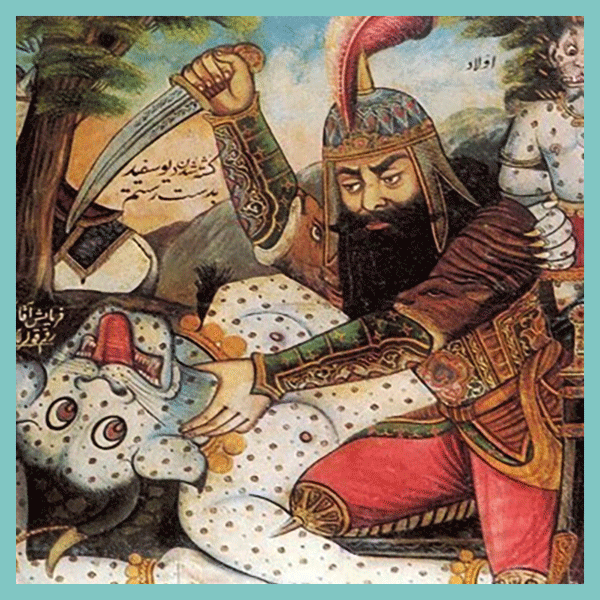
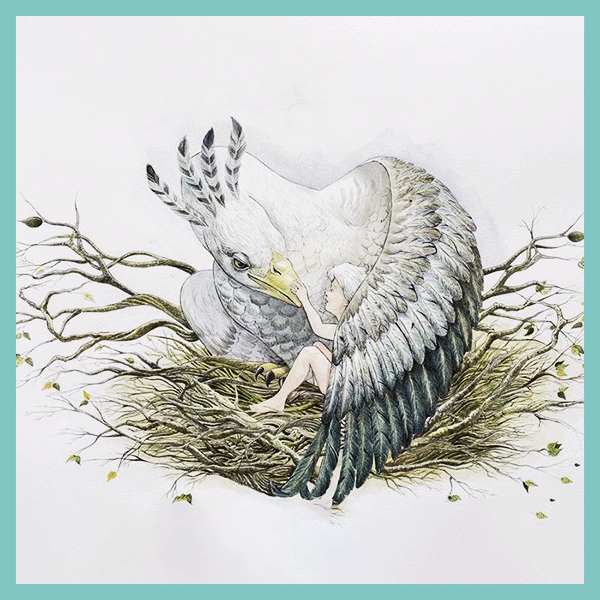
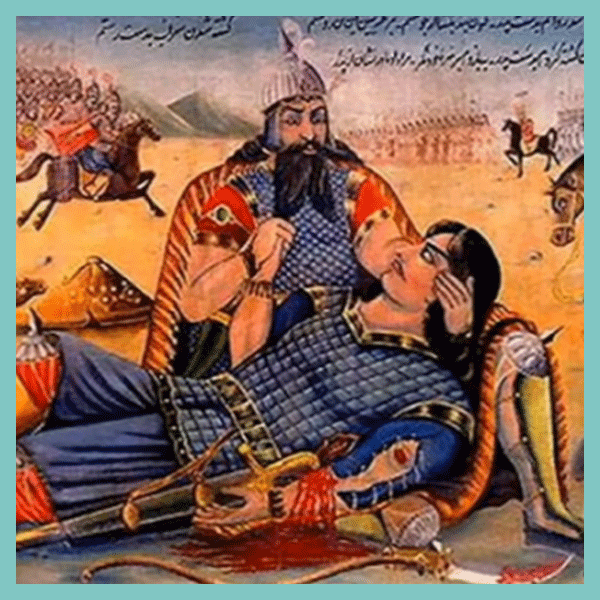
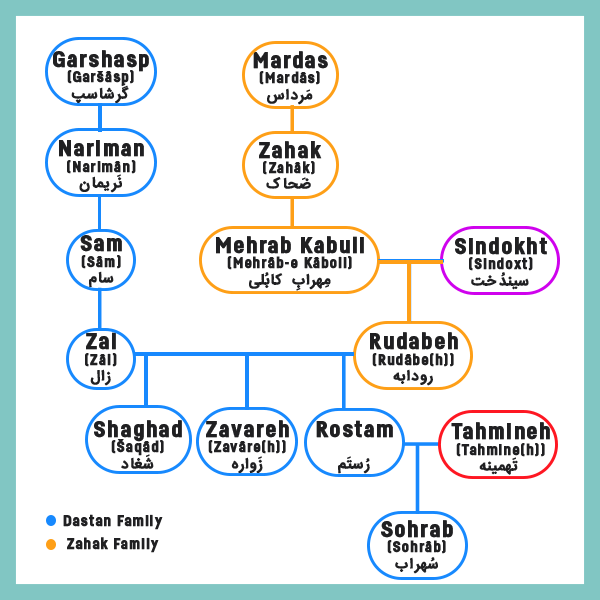

Leave A Comment